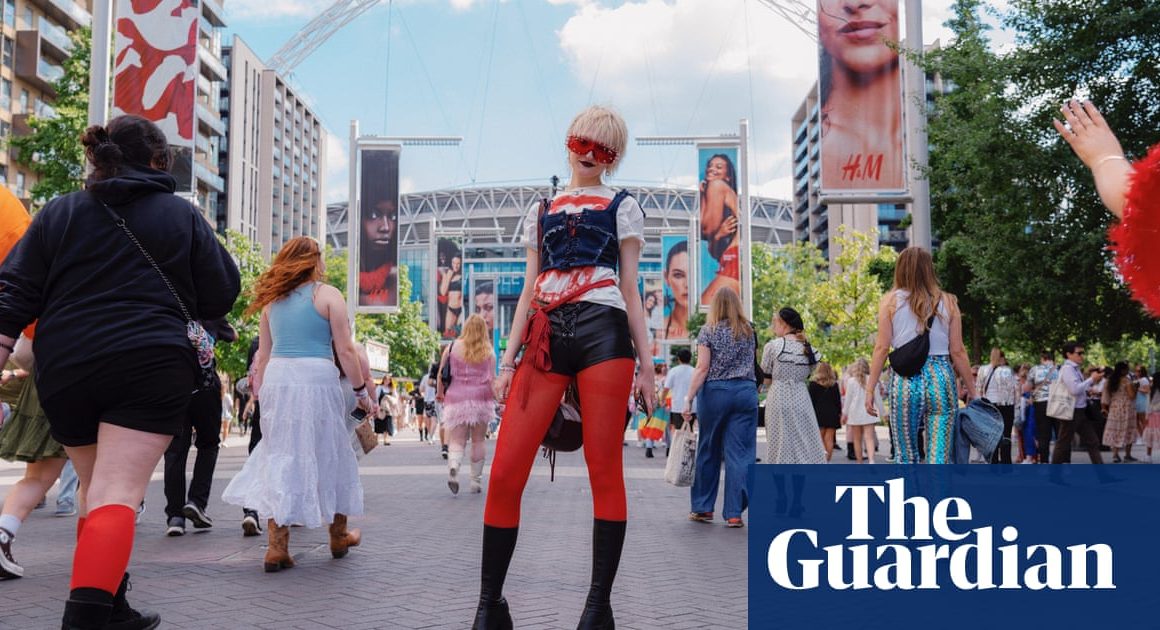Itâs the middle of August 2023 and the Danish It-girl brand Ganni is throwing a party to celebrate the last night of Copenhagen fashion week. In a room hidden behind a heaving dancefloor, Paloma Elsesser, the curve New York model who opened Ganniâs show hours before, is dominating the karaoke room and creative director Ditte Reffstrup is dancing on the bar.
It feels like a celebration from a different era. Independent designers are struggling. The news of Matches Fashionâs closure in March was followed by announcements that the Vampireâs Wife and Mara Hoffman would shut down. Roksanda had filed a notice of intent to appoint an administrator, a fate avoided only by the entrance of a buyer. All offer similarly playful garments and are, in many ways, despite higher prices, Ganniâs peers. But the Danish brand, which Reffstrup took over in 2009 alongside her husband, Nikolaj, has reason to be cheerful.
The brand is stocked at more than 600 retailers globally and has 70 concept stores across Europe, North America and Asia. The Ganni Girls hashtag, a social media calling card for anyone wearing the brand, has been used more than 111,000 times on Instagram. Laura du Rusquec, the former deputy CEO of Balenciaga, was recently named CEO. In 2017, LVMH-backed investment firm L Catterton bought 51% of the business. Last year, Ganni launched a series of high-profile collaborations that included Barbour, New Balance and Dr Martens and in May this year a line in collaboration with Elsesser.
If you havenât heard of Ganni, you have probably seen it. For several years it has been the choice brand of a certain well-heeled young professional, offering easy-to-wear, feminine garments that can be worn at the office and for the bike ride in, or to dinner out afterwards. They represent the sartorial side of the Scandimania that took over our lives in recent years, from TV to baked goods and furniture.
True to Scandi-form, Ganni is big on sustainability, too. It has set the ambitious goal of halving its emissions by 2027 and, according to its latest responsibility report (the brand eschews the word âsustainabilityâ due to overuse) in 2023, Ganniâs carbon emissions were 7% lower than a 2021 baseline â despite revenue growing by an average of 18%. It is an impressive achievement that timed perfectly with the publication of The Ganni Playbook: How to Get Started Creating a Responsible Business, a sort of sustainable business manifesto out now.
Almost 10 months have passed since the party, and I am back in Copenhagen, sitting in the Reffstrupsâ eclectic, airy home â the living room is all bright colours and natural textures â to talk about the book and the formula that keeps Ganni, and the look it epitomises, thriving against the odds.
The couple themselves are a good place to start. They met on a dance floor 20 years ago and were married in seven months. âShe was always wearing a mix of vintage so she would kind of look like the lead singer from Bananarama one day and something else the next,â says Nicolaj, some helium balloons â probably from one of their three childrenâs parties â bobbing against the ceiling behind him. Today Ditte is wearing an oversized silver blazer, a white T-shirt, against which a turquoise pendant hangs, and a black pointelle skirt.
A few years after they met, Ditte â an experienced fashion buyer â was approached to design some cashmere garments for a friendâs small fashion label called Ganni. Nicolaj was working in tech start-ups and understood how to scale a brand. Together, they identified a customer who was not being served by the minimalist, normcore Scandi designers that were popular in 2009 and decided to take over the business.The customer they identified as underserved was essentially Ditte â the original so-called Ganni Girl. She has proven to be the businessâs silver bullet, embodying something aspirational that appeals to women of many ages, nationalities and body types, as well as having a keen understanding of what women want from clothes.
While the term Ganni Girl may sound like cloying marketing jargon, it came about shockingly, almost irritatingly organically. In 2015, the model Helena Christensen came to lunch with a friend, the actor Kate Bosworth. Both wore the same Ganni jacket. They snapped a selfie, wrote #GanniGirls in the caption and a clique was born.
â[The Ganni Girl may] not be the most obviously beautiful girl in the room or wearing the most trendy clothes,â says Ditte. âBut sheâll just have this certain aura around her â an energy and the confidence that comes when you dress for yourself and no one else.â The term has inspired a coffee table book and the trope has even made it into literature. In his Sunday Times bestseller, Trivial Pursuits, the writer Raven Smith describes a drunk party trick so misguided it resulted in âmuch spilled prosecco and many a drenched Ganni dress.â The line is a gripe â the Ganni girl can be seen as a bit, in modern parlance, âbasicâ. But it shows how far she has come.Ganni has been shrewd, capitalising on the immediacy and community social media offers by focusing on local influencers that have a more engaged following over celebrities with bigger audiences. Although the hashtag was a happy accident, building a community around it was strategic.
For all its local roots, Nicolaj knew the brand would not survive if it did not work for customers outside Denmark. Ganniâs outlook has always been purposefully global.
They have kept prices accessible, believing it would help the brand to endure. âIt has always been a joy to create something that people actually use,â says Ditte. âLike having a restaurant that people actually enjoy eating in, or making music that people are actually listening to.â
The only time Ganniâs pursuit of the best product is forsaken is when it comes into conflict with achieving their carbon goals. If the book has one recurring theme it is how to make money without maximising it at the expense of the planet. This will be interesting to watch play out over the next few years â to halve their emissions they will have to focus on materials, which are responsible for 58% of Ganniâs total carbon footprint.
Ditte is honest about her design perspective on sustainability: initially she only saw limitations. But Ganni has become a champion of, and investor into, next-generation materials and one of their biggest achievements was phasing out virgin leather at the end of 2023, which accounted for a third of the brandâs carbon footprint. Doing so meant discontinuing two colour ways of their best-selling cowboy boots at a cost to the company of £300,000 a year.
Nicolaj is upfront about how expensive it is to be a responsible business. Thereâs a âdirect investment thatâs invisible ⦠in the certifications, the consultants, the premium fabrics,â he says. But what hurts more is âthe sacrifices, the frustrations, like the letting go of bestsellers and saying no to collaborations.âOf course for all of the worthy talk, like all fashion brands, the business is far from faultless â synthetic materials, which are blended through most of Ganniâs garments, shed microfibres into the ocean, will never biodegrade and currently, are not able to be recycled. Nicolaj returns to a tech tagline again and again: heâd rather build knowledge through trying and failing, being clear on the vision and loose on the details, rather than not trying at all. If nothing else, Nicolaj promises: âGanni is honest, not perfect.â
The Ganni Playbook: How to Get Started Creating a Responsible Business by Nikolaj Reffstrup with Brooke Roberts-Islam, is published on 27 June by Penguin.









